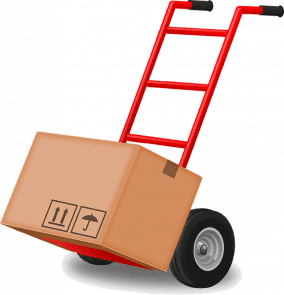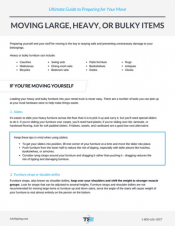Whether you’ve rented a moving truck, hired movers, or are shipping your belongings to your new home, moving large items without damaging them (or injuring yourself) is always a challenge.
Heavy or bulky furniture can include:
- Sofas
- Mattresses
- Bicycles
- Swing sets
- Dining room sets
- Bedroom sets
- Patio furniture
- Bookshelves
- Desks
- Rugs
- Antiques
- Clocks
Preparing yourself and your stuff for moving is the key to staying safe and preventing unnecessary damage to your belongings. Don't want to worry about the heavy lifting?
If You Hired Movers
Professional moving companies should be able to supply any necessary equipment such as sliders, blankets, and dollies. When you book your movers, make sure you let them know what furniture you have so they know what equipment to bring along on moving day. You should also confirm that there are no extra fees associated with using their equipment, and ensure that any fees are noted in your moving contract before you sign.
Before your moving day arrives, there are a few things you can do prepare your furniture and make the loading process smoother on the day:
- Remove legs from tables, couches, and chairs.
- Empty drawers and shelves.
- Disassemble any furniture that can be disassembled.
- Tape screws and other components to the furniture it came from, or place them in a bag and label it. Number and label the parts if necessary.
- Clear obstacles out of the way and make sure there’s a clear path in and out of your place.
- Remove doors if necessary.
- Cover floors and banisters in cardboard or towels to protect them against damage.
- Wrap and pack your mattress in a mattress box before your movers arrive.
If You’re Shipping Your Furniture
Shipping is ideal for long distance or interstate moves, as well as for getting bulky, difficult-to-move furniture to your new home. It’s illegal to drive with an improperly secured load - if your mattress isn’t securely tied to the roof of your car, for example.
Unless you’ve booked a White Glove shipment, preparing your furniture for shipment is similar to if you’ve hired a professional moving company. All it takes is a few simple steps to make sure your furniture is safe and secure before it gets loaded onto the truck. Here are our tips for preparing your furniture for shipment:
- Protect corners and delicate parts with bubble wrap or corrugated cardboard first, then wrap the entire piece of furniture in moving blankets. Secure the blankets with tape, ensuring that the tape doesn’t adhere directly onto any painted or polished surfaces.
- Consider wrapping your furniture (after it’s been wrapped in blankets, that is) in plastic wrap. In addition to keeping moving blankets in place, plastic wrap also prevents dust and grime from getting on your item. Just make sure you poke holes so that mold doesn’t form, and that the plastic doesn’t come into contact with the hard surface of your furniture - plastic wrap can damage surfaces if your furniture gets hot in transit.
- Cover glass surfaces with cardboard, then wrap in bubble wrap and place in a box. You can also tape a large X onto the glass in case it does break - this makes it less likely to completely shatter.
- Roll rugs around a PVC pipe, then wrap in plastic wrap or place into a box if you can find one that’s large enough. Learn more about shipping an area rug.
- If you’re shipping your mattress, place it in a plastic bag, then into a mattress box. Pad it with moving blankets for extra protection, and label the box. Need a mattress box? Order one from our supply shop.
If You’re Moving Yourself
No matter how many friends you can lasso into helping you move, loading your heavy and bulky furniture into your rental truck is never easy. Thankfully, there are a number of tools you can pick up at your local hardware store to help make things easier. Here are some of the most common:
1. Sliders
It’s way easier to slide your heavy furniture across the floor than it is to pick it up and carry it, but you’ll most likely need special sliders to ease the process. If you’re sliding your furniture over carpet, you’ll need hard plastic; if you’re sliding over tile, laminate, or hardwood flooring, look for soft padded sliders.
| PRO TIP: Frisbees are a good low-cost alternative, as are towels and cardboard. Just stay away from your good guest towels. |
To get your sliders into position, lift one corner of your furniture at a time and move the slider into place.If you’re using sliders, keep these tips in mind:
- Push furniture from the lower half to reduce the risk of tipping, especially with taller pieces like hutches, bookshelves, or armoires.
- Consider tying straps around your furniture and dragging it rather than pushing it - dragging reduces the risk of tipping and damaging furniture.
2. Furniture straps or shoulder dollies
Furniture straps, also known as shoulder dollies, loop over your shoulders and shift the weight to stronger muscle groups by using leverage to take the full weight of the furniture off your back. Look for straps that can be adjusted to several heights.
Bear in mind that furniture straps and shoulder dollies are not recommended for moving large items or furniture up and down stairs, since the angle of the stairs will cause weight of your furniture to rest almost entirely on the person on the bottom.
3. Moving blankets
Moving blankets are essential for protecting your furniture against damage. They’re also a good alternative to sliders; instead of being placed under the corners of your furniture, tilt your furniture if it’s safe to do so and slide one blanket under two corners, then repeat on the other side using a second blanket.

4. Dollies or hand trucks
Dollies are small square platforms with four wheels, and are perfect for transporting heavy or bulky furniture or stacks of boxes.
Hand trucks have two wheels and stand upright with a small platform on the bottom. They are ideal for taller furniture like bookcases or dressers, but aren’t recommended for heavy furniture since it’s only your strength keeping the furniture upright.
5. Mattress sling
Mattress slings are invaluable tools for moving your mattress, and they’re easy to DIY. Simply thread a rope through the mattress handles, slip some PVC pipe over the rope ends, and tie the rope to create a grip.
|
PRO TIP: You can also cut and fold your box spring to make moving it easier. Here’s how:
Check out this tutorial for more detailed instructions. |
Moving Large Items without Tools
If you don’t have access to any of these tools, you can lift and move your furniture without them. Make sure you follow these tips:
- Use a high-low method: Tilt the furniture backwards, with one person carrying the top and another carrying the bottom. Maintain this angle as you move. The high-low method is ideal for taller pieces of furniture, and it makes traversing stairs slightly easier.

- Bend from the knees and hips. Use your core and your legs to lift, rather than bending from the waist and lifting from your back like the picture below Make sure you lift correctly by starting in the squat position, then using your legs to push yourself upright.
- Turn chairs on their side so they make an L-shape. This makes it easier to hook them around corners and fit them through doors.
- Take the legs off and remove drawers to make your furniture lighter and more maneuverable. You can also keep your stuff in the drawers to make unpacking easier.
- Protect furniture with blankets and plastic. First, wrap your stuff in blankets, then secure the blankets in place using plastic. This helps to prevent damage to the finish or any fragile edges.
- Empty your furniture before moving it. This makes it lighter and easier to transport. If drawers can’t be removed, secure them with tape so they don’t slide open unexpectedly.
- Load heavy furniture onto the truck first, then pack in your boxes.

